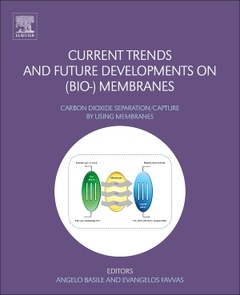Current Trends and Future Developments on (Bio-) Membranes Carbon Dioxide Separation/Capture by Using Membranes
Auteurs : Basile Angelo, Favvas Evangelos P.

Current Trends and Future Developments on (Bio-) Membranes: Carbon Dioxide Separation/Capture by Using Membranes explores the unique property of membranes to separate gases with different physical and chemical properties. The book covers both polymeric and inorganic materials for CO2 separation and explains their mechanism of action, allowing for the development and most appropriate and efficient processes. It also lists the advantages of using membranes instead of other separation techniques, i.e., their low operating costs and low energy consumption. This book offers a unique opportunity for scientists working in the field of membrane technology for CO2 separation and capture.
Part 1. Polymeric Membranes for CO2 separation1. Polymeric membrane materials for CO2 separations2. Already used and candidate polymeric membranes for CO2 separation plants3. CO2 selective membranes: How easy is their moving from laboratory to industrial scale?4. Mixed matrix membranes for CO2 separations: preparation and properties5. CO2/CH4 separation (natural gas purification) by using MMMs
Part 2. Inorganic Membranes for CO2 separations6. Ceramic membranes: preparation, properties and investigation on CO2 separation 7. CO2/CH4 separation by using carbon membranes8. Poly(ionic liquid) membranes for CO2 separation9. Fixed-site-carrier (FSC) membranes for CO2 removal from natural gas10. Hybrid membranes (metallic membranes) for CO2 separation processes
Part 3. Membranes for post-combustion and pre-combustion CO2 capture11. CO2 capture from coal-fired power plants (cement factory, electricity power plants etc)12. IGCC: Integrated gasification combined cycle and CO2 capture13. Facilitated transport membranes for CO2/H2 separation14. Membrane considerations and plant design for post-combustion CO2 capture15. Design considerations for post-combustion CO2 capture with membranes
Part. 4 Membrane reactors in Integrated Gasification Combined Cycles for CO2 separations16. Hybrid membranes for CO2 removal from high pressure natural gas17. Membrane optimization and process condition investigation for enhancing the CO2 separations from NG18. Techno-Economic Assessment of Polymeric, Ceramic and Metallic Membranes Integration in an Advanced IGCC Process for CO2 separation and capture
Part 5. Membranes for CO2 removal from natural gas: status and perspectives19. Natural gas compositions: which are the requested separations for them?20. Polymeric, Ceramic, Carbon or hybrid/MMMs membranes for the CO2 removal processes from NG?21. Membranes for NG separation processes: Recent progress and future perspectives
Chemists and chemical engineers resaerchers in the area of membranes and carbon dioxide utilization, Environmental engineers, energy companies. It could be used in advanced Chemical Engineering courses and a key reference text for R&D managers in industry interested in the development of gas separation engineering
Angelo Basile, a Chemical Engineer with Ph.D. in Technical Physics, is author of hundreds of papers, books, chapter-books, and Special Issues in the field of Membrane Science and Technology, with also various Italian, European and worldwide patents. He is an Associate Editor of various int. journals (IJHE, APCEJ, etc), Editor-in-Chief of the Int. J. Membrane Sci. & Techn., and member of the Editorial Board of more 25 int. journals. Today Basile is working at General TAG, Via Mastri Ligornettesi n. 28, Ligornetto 6853 – Switzerland.
Evangelos P. Favvas is a Senior Researcher at the Institute of Nanoscience and Nanotechnology in NCSR “Demokritos, Athens - Greece. He has 80 scientific papers in peer-reviewed journals and 100 articles in international congresses; editor of 2 scientific books, 2 Greek and 4 worldwide patents. His research interests embrace the experimental study of gas separation, with emphasis on carbon dioxide and hydrogen separations, using membranes, sorbents and hybrid porous materials. The in-situ study of condensation process using the combination of X-ray and neutron scattering and adsorption techniques is another filed of his interests.
- Outlines numerous membrane-based technologies for CO2 separation and capture
- Lists new, advanced separation techniques and production processes
- Includes various applications, modelling, and the economic considerations of each process
- Covers advanced techniques for the separation of CO2 in natural gas
Date de parution : 07-2018
Ouvrage de 668 p.
19x23.3 cm
Thèmes de Current Trends and Future Developments on (Bio-) Membranes :
Mots-clés :
Amine fixed-site-carrier; Carbon dioxide (CO2)Gas separation; Carbon dioxide separation plants; Carbon dioxide separation; Carbon dioxide; Carbon membrane; Ceramic membranes; CH4CO2Gas separation; CO2 capture; CO2 from natural gas; CO2 removal; CO2 separation; CO2 sequestration; CO2/CH4 mixture; CO2/CH4Fillers; CO2Gas separation; CO2-selective membrane; Coal-fired power plant; Composite membranes; Design; Economic assessment; Environmental challenges; Facilitated transport membrane; Facilitated transport membranes; Fixed-site-carrier; Gas sweetening; Glassy polymers; Hybrid membrane; Hybrid membranes; IGCC plant; Inorganic membrane; Integral asymmetric membranes; Integrated gasification combined cycle; Ionic liquid; Ionic liquids; Membrane module; Membrane preparation; Membrane processes; Membrane properties; Membrane reactors; Membrane separation system and process; Membrane separation; Membrane technologies; Membrane technology; Membrane; Membranes; Mixed matrix membrane; Mixed matrix membranes (MMMs)Natural gas purification; Natural gas treatment; Natural gas; Permeability; Plant design; Polyimides; Polymer precursor; Polymer; Polymeric membrane; Polymeric membranes; Postcombustion application; Postcombustion capture; Postcombustion process; Postcombustion; Precombustion capture; Precombustion CO2 capture; Precombustion; Rubbery polymers; Selectivity; Separation performance; Separation processes; Separation; Shift reaction; Silica membranes; Transport properties; WGS membrane reactors



